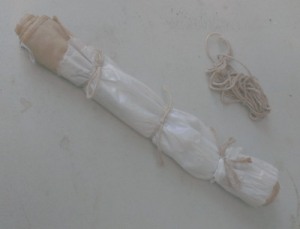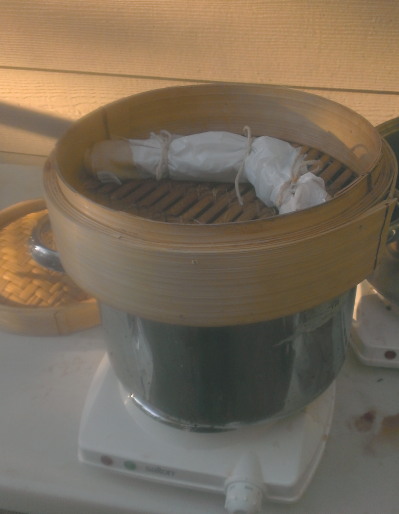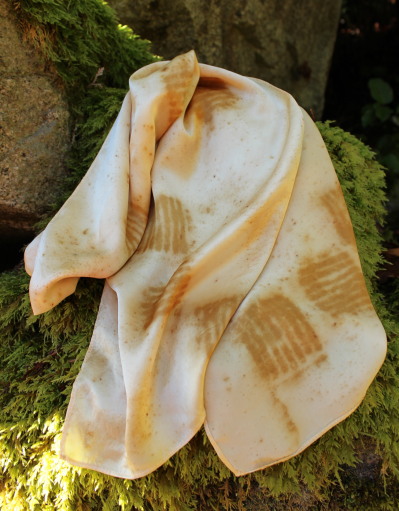My dear friend and wonderfully creative fibre artist behind the Ruby Slippers blog has made some beautiful fabric pieces by eco-dyeing—rolling flowers and leaves into little bundles, then steaming them. She has to leave these bundles alone for several weeks to ensure that the colours are imprinted, and when she can finally open them, the results are marvelous.
Eco-dyeing with mushrooms presents its own challenges, but when I noticed a layer of “dust” in the bottom of a box holding a bunch of dried Dyer’s Polypore (Phaeolus schweinitzii), a tiny light bulb sparked an idea. I dyed some silk scarves in a Phaeolus dyepot and removed them before the colour became too intense. Then I put them immediately into a pot of simmering water—a stop bath—to set the colour. Then I got to play, and here’s what happened.

I scooped up a few handfuls of Phaeolus bits—as the fungus dries, it seems to shed its layer of pores, which have turned dark brown, but I reasoned these bits would still contain pigment.

My search for something handy to use as a “stencil” took me to the kitchen utensil drawer. My dearest, who does all the cooking, probably wouldn’t have condoned my taking this up to my studio to be covered in inedible fungus dust, but in matters of mushroom dyeing, it’s always safer to follow the “ask forgiveness” rule. I sprinkled the bits into the slots with a liberal hand, then gave the whole thing a good spritz of water to keep everything in place. With care, I lifted the slotted spoon off the fabric, pleased to see that the design had stayed in place. I soon discovered, though, that the mushroom bits had minds of their own and were scattering themselves outside the design area. So I went along and sprinkled bits over the scarf’s surface, hoping for a speckled background.


I’d laid the scarf out on a long piece of plastic (cut from one of those ubiquitous shopping bags that I swear procreate under the kitchen sink) and began rolling, taking care not to disturb my designs.


Then it was a simple matter of tying the scarf tightly in three places . . .

. . . and putting it into a bamboo steamer where it steamed for thirty minutes one day and thirty minutes the next. (I did that because of timing—ordinarily I would have steamed it for an hour the first time.)
I decided not to wait three weeks to see the results. I figured the bits of Phaeolus would impart their colour quickly and permanently . . .

. . . and they did!

























